Toshiba 40AV700V, 40AV700T, 40AV700E, 32AV700T, 32AV700V User Manual
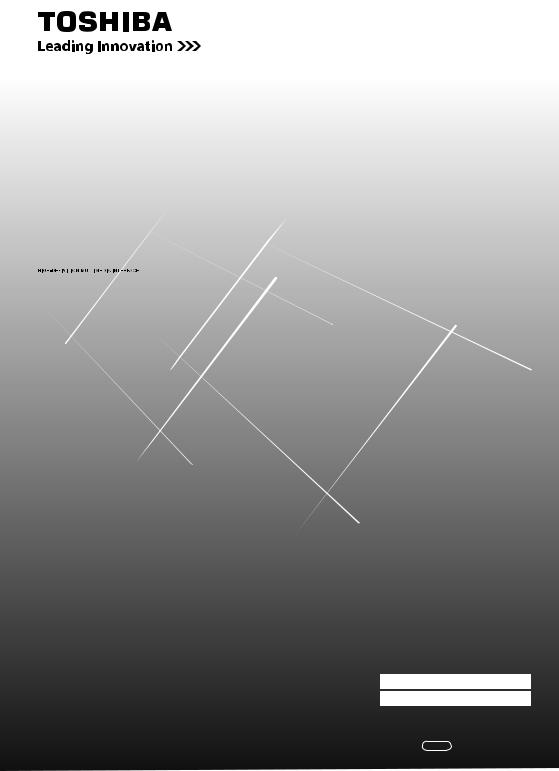
OWNER'S MANUAL
LCD Colour TV



 ®
®
32AV700E
32AV700T
32AV700V
40AV700E
40AV700T
40AV700V
Owner's Record
You will find the model number and serial number on the back of the TV. Record these numbers in the spaces provided below. Refer to them whenever you call upon your TOSHIBA dealer regarding this product.
Model number: Serial number:
©2010 TOSHIBA CORPORATION |
TD/J |
|
All Rights Reserved |
VX1A00160300 |
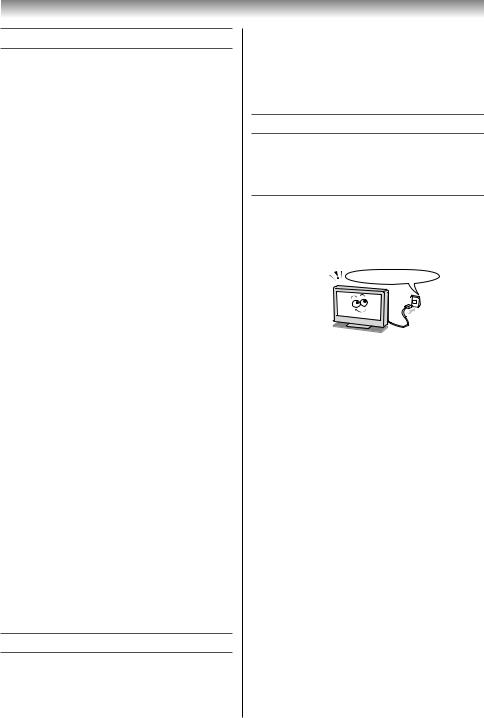
Introduction / Getting started
Contents
Introduction / Getting started
Connecting an aerial 7 Exploring your new TV 7 TV front and side panel controls 7 TV back panel connections 8 Learning about the remote control 9 Turning the TV on 10 Tuning the TV for the first time 10 Using the Quick Menu 11 Learning about the menu system 11 Watching TV programmes 12 Programming channels into
the TV’s channel memory 12
Using the TV’s features
Picture adjustment 15 Sound adjustment 18 Other features settings 19 Selecting the video input
source to view 20 Channel List 21 Teletext 21
Connecting your TV
Back connections 24 Connecting HDMI or DVI devices 24 Selecting the PC/HDMI 1
Audio mode 25 Setting the HDMI 1 Audio mode 25 Connecting a computer 26 Using the PC Settings 27 Using the Media Player 27
Reference section
Troubleshooting 30 Broadcast system 30 Specifications 31
Welcome to Toshiba
•Thank you for purchasing this Toshiba LCD
Colour TV.This manual will help you use the exciting features of your new TV.
•Instructions in this manual are based on using the remote control.
•You also can use the controls on the TV if they have the same name as those referred to on the remote control.
•Please read all safety and operating instructions in this manual carefully, and keep this manual for future reference.
Important Safety Instructions
Be sure to observe the following instructions and precautions to ensure safe use of this TV.
Installation
1)Always connect the power plug to an appropriate electrical outlet equipped with 110-240V, AC 50/60Hz.
Never use the TV outside the specified voltage range. It may cause a fire or an electric shock.
Ex. 110-240V AC, 50/60Hz
Check! 
WARNING ABOUT THREE-WIRE
GROUNDING-TYPE PLUG:
•This product shall be connected to a main socket outlet with a protective earthing connection.
•Never remove the earthing pin on the power plug.This system is equipped with a three pin earthing-type power plug.This plug will only fit an earthing-type power outlet.This is a safety feature. If you are unable to insert the plug into the outlet, contact an electrician to replace the wall outlet.
•Never defeat the purpose of the earthing plug.
About the fuse (Only for E models)
In a three pin earthing-type, the fuse fitted in this plug is approved by ASTA or BSI to BS1362. It should only be replaced by a correctly rated and approved type and the
fuse cover must be refitted.
About the earth
An appliance with protective earth terminal should be connected to a mains outlet with a
protective earth connection.
About the use
•Make sure to insert the plugs firmly, when plugging the AC power cord into the TV set end and wall outlet end.
•Make sure to hold the plug, when unplugging the AC power cord.
2
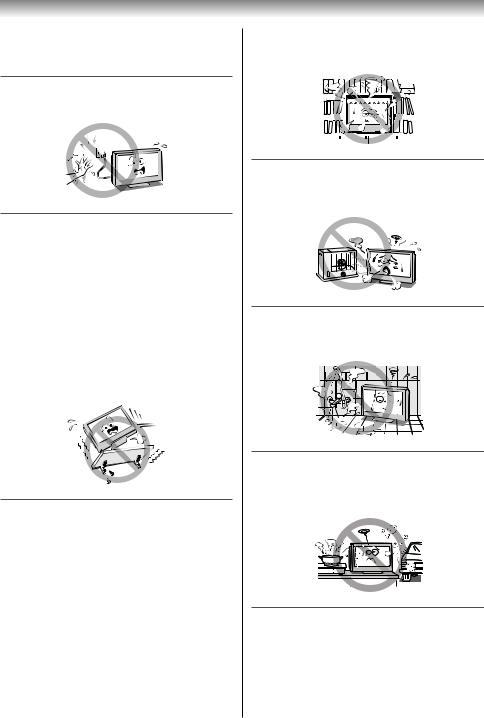
Introduction / Getting started
•Never use other cord except for supplied AC power cord, and never use the supplied power cord for any other purpose.
2)Never insert or remove the power plug with wet hands.
This may cause an electric shock.
3)Never place the TV in an unstabilized location such as on a shaky table, incline or location subject to vibration.
•Only use cabinets or stands recommended by the TV manufacturer.
•Only use furniture that can safely support the TV.
•Ensure that the TV is not hanging over the edge of the supporting furniture.
•Never place the TV on tall furniture (for example, cupboards or bookcases) without anchoring both the furniture and the TV to a suitable support.
The TV may drop or fall off, which may cause an injury or damage.
4)Never block or cover the slots and openings in the cabinet.
•Never place the TV so that it is facing upward or on its side.
•Never place the TV in a closet, bookcase or other similar area where the ventilation is poor.
•Never drape a newspaper, tablecloth or curtain on the TV.
•Never stand the TV on cloth or other material placed between the TV and supporting furniture.
•When installing the TV against a wall, always keep the TV at least 10 cm away from the wall.
•Never place the TV on a soft unstable surface, such as a carpet, or a cushion.
The inside of this TV will overheat if the ventilation holes are covered, blocked or sealed, which may result in a fi re.
5)Never place the TV near a heater or in direct sunlight.
The surface of the cabinet or power cord may melt and result in a fi re or an electric shock.
6)Never place the TV in an area exposed to high humidity levels, such as in a bathroom or close to a humidifier.
This may cause a fi re or an electric shock.
7)Never place the TV next to a stove where it will be exposed to oil, smoke, or steam, or in a location where there is a large quantity of dust.
This may cause a fi re or an electric shock.
8)Install the TV in a horizontal, stable location. Attach the TV to the stand with the mounting screw (not supplied).
•If the TV is not installed securely, it may lean or fall over and cause an injury.
3
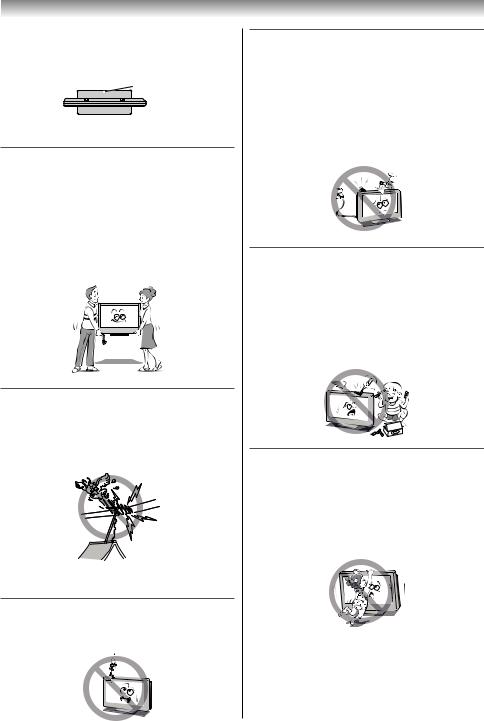
Introduction / Getting started
•To prevent injury, use the exclusive optional stand or wall-hanging bracket to install this TV on the floor or wall securely in accordance with a qualified technician.
Screw hole
Top view
9)Precautions for moving the TV
•When moving the TV, be sure to remove the plug from the wall outlet and disconnect the aerial cable and audio/video cables, any steady ties and mounting screw. A fire or an electric shock may result if the power cord is damaged.
•When carrying the TV, at least two people are needed. Be sure to carry it upright.
•Never carry the TV with the screen facing up or down.
2)The apparatus shall not be exposed to dripping or splashing and that no objects filled with liquids, such as vases, shall be placed on the apparatus.
When liquids are spilled or small items are dropped inside the TV, this may cause a fire or an electric shock.
If small objects drop inside the TV, turn off the TV and remove the power plug from the outlet immediately and contact a service technician.
3)Never insert objects (metal or paper) or pour water inside the TV through ventilation holes and other openings.
These items may cause a fire or an electric shock. If these objects are inserted inside the TV, turn off the TV and remove the power plug from the outlet immediately and contact a service technician. Be especially careful that children do not insert objects in the TV.
10)Precautions for installing on outdoor aerial
An outside aerial system should not be located in the vicinity of overhead power lines, or other electric light or power circuits.
If the aerial falls down or drops, it may cause an injury or an electric shock.
Use
1)Never place hot objects or open flame sources, such as lighted candles or nightlights, on or close to the TV.
High temperatures can melt plastic and lead to fires.
Clip
4)Never stand or climb on the TV.
•Educate children about the dangers of climbing on furniture to reach the TV or its controls.
Be especially careful in households with children to prevent them through climbing on top of the TV. It may move, fall over, break, become damaged or cause an injury.
4
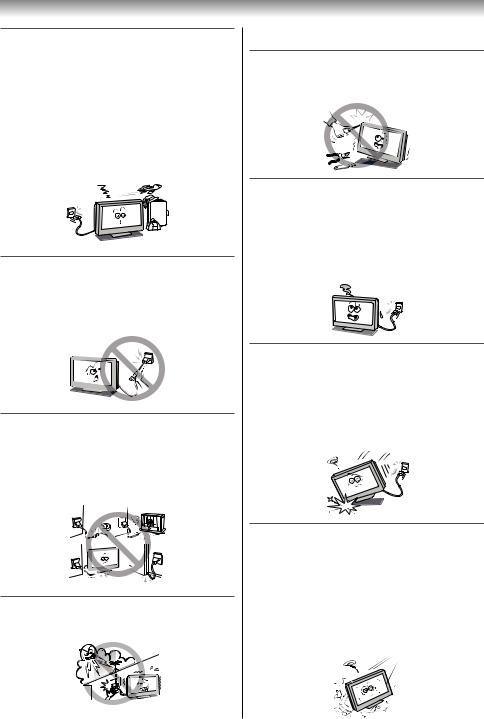
Introduction / Getting started
5)When the TV will not be used for a long period of time, such as during vacation or travel, remove the power plug from the wall outlet for safety.
•The TV is not completely disconnected from the power supply line, as minute current is consumed even when the ! Power switch is turned off.
•The Mains plug or an appliance coupler is used as the disconnect device, therefore the disconnect device shall remain readily operable.
6)Never pull on the power cord when removing the plug from the wall outlet.
Always hold the plug fi rmly when removing it. If the power cord is yanked, the cord may become damaged and a fi re or an electric shock may occur.
7)Never cut, break, modify, twist, bunch up or bent the cord or apply excessive force or tension to it.
Never place heavy objects on the cord or allow it to overheat as this may cause damage, a
fi re or an electric shock. Contact a service technician if the power cord is damaged.
8)If there is thunder or lightning, never touch the aerial cable or other connected cables.
You may suffer an electric shock.
Service
1)Never repair, modify or disassemble the TV by yourself.
It may cause a fi re or an electric shock. Consult a service technician for inspection and repairs.
2)When a malfunction occurs, or if smoke or an unusual odor comes from the TV, turn off the TV and remove the power plug from the outlet immediately.
Make sure that the smoke or smell has stopped, then contact a service technician. If the TV is still used in this condition, it may cause a fi re or an electric shock.
3)If the TV is dropped or the cabinet is broken, turn off the TV and remove the power plug from the outlet immediately.
If the TV has power in this condition, it may cause a fi re or an electric shock. If the cabinet is broken, be careful when handling the TV to prevent an injury.
Contact a service technician for inspection and repair.
4)When the TV reaches the end of its useful life, ask a qualified service technician to properly dispose of the TV.
Note:
The lamp unit contains a small amount of mercury. Disposal of mercury may be regulated due to environmental considerations.
Dispose of the used lamp unit by the approved method for your area. For disposal or recycling information, please contact your local authorities.
5

Introduction / Getting started
Cleaning
1)Remove the power plug before cleaning.
Never use solvents such as benzine or thinner to clean the TV.
•These solvents may distort the cabinet or damage its finish.
•If rubber or vinyl products remain in contact with the TV for a long time, a stain may result.
If the cabinet becomes dirty, clean it with a soft, dry cloth.
When cleaning the surface of the LCD display, wipe the panel surface gently with a soft, dry cloth.
2)Periodically disconnect the power plug from the outlet and check it.
If dust has collected on the power plug connectors, clean off the dust with a dry cloth.
This dust may cause a fire due to reduced insulation on the plug.
Clean here
Important information
1)About LCD screen
•If you have the LCD screen facing to the sun, the LCD screen will be damaged. Be aware of locating the TV close to a window or outdoors.
•Never press the LCD screen strongly or scratch it, and never put anything on it. These actions will damage the LCD screen.
2)About cabinet and LCD screen
Never spray volatile compounds such as insecticide on the cabinet and LCD screen. This may cause a discolouration or damage the cabinet and LCD screen.
3)Some pixels of the screen do not light up
The LCD display panel is manufactured using an extremely high level of precision technology, however sometimes some pixels of the screen may be missing picture elements or have luminous spots.This is not sign of malfunction.
4)About Interference
The LCD display may cause interference in image, sound, etc. of other electronic equipment that receives electromagnetic
waves (e.g. AM radios and video equipment).
5)About using under the low temperature places
If you use the TV in the room of 0°C or less, the picture brightness may vary until the LCD monitor warms up.This is not a sign of malfunction.
6)About afterimage
If a still picture is displayed, an afterimage may remain on the screen, however it will disappear.This is not a sign of malfunction.
Exemptions
•Toshiba is not liable for any damage caused by fires, natural disaster (such as thunder, earthquake, etc.), acts by third parties, accidents, owner’s misuse, or uses in other improper conditions.
•Toshiba is not liable for incidental damages (such as profit loss or interruption in business, modification or erasure of record data, etc.) caused by use or inability to use of product.
•Toshiba is not liable for any damage caused by neglect of the instructions described in the owner’s manual.
•Toshiba is not liable for any damage caused by misuse or malfunction through simultaneous use of this product and the connected equipment.
Trademark Information
•HDMI, the HDMI logo, and High-Definition Multimedia Interface are trademarks or registered trademarks of HDMI Licensing LLC in the United States and other countries.
6
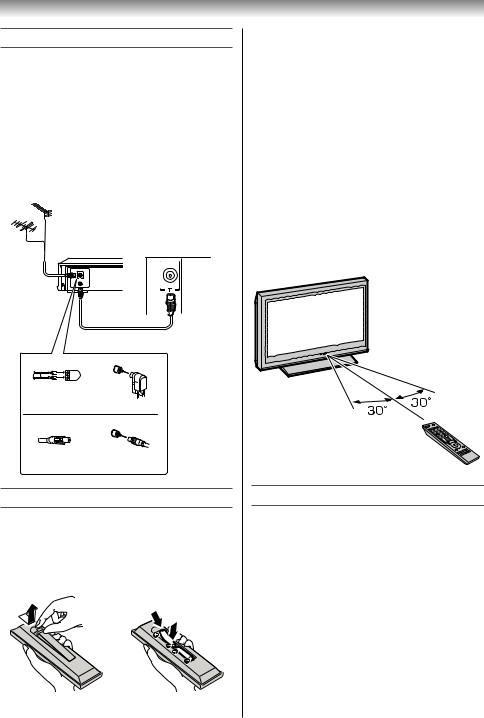
Introduction / Getting started
Connecting an aerial
Optimum reception of colour requires a good signal and will generally mean that an outdoor aerial must be used.
The exact type and positioning of the aerial will depend upon your particular area.
Your Toshiba dealer or service personnel can best advise you on which aerial to use in your area.
Before connecting the aerial cable, turn off all main power switches.
VHF and/or
UHF aerial
Media Recorder |
TV back view |
|
IN |
|
|
Aerial cable (75 7 coaxial) |
||
(not supplied) |
|
|
300 7 twin-lead feeder |
|
|
Aerial adaptor |
75 7 |
|
(not supplied) |
aerial |
|
|
terminal |
|
75 7 coaxial cable |
|
|
Plug |
75 7 aerial |
|
(not supplied) |
|
|
terminal |
|
|
Exploring your new TV
Installing the remote control batteries
Remove the battery cover.
Insert two R03 (AAA) batteries matching the –/+ polarities of the battery to the –/+ marks inside the battery compartment.
Cautions:
•Dispose of batteries in a designated disposal area. Batteries must not be exposed to excessive heat such as sunshine, fire or the like.
•Attention should be drawn to the environmental aspects of battery disposal.
•Never mix battery types or combine used batteries with new ones.
Notes:
•If the remote control does not operate correctly, or if the operating range becomes reduced, replace both batteries with new ones.
•If the batteries are dead or if you will not use the remote control for a long time, remove the batteries to prevent battery acid from leaking into the battery compartment.
Effective range
within 5 m
TV front and side panel controls
•You can operate your TV using the buttons on the side panel or the remote control.The back of the panel provide the terminal connections to connect other equipment to your TV (- “Connecting your TV” pages 24 – 29).
•For the use of each control, see the pages in brackets.
7
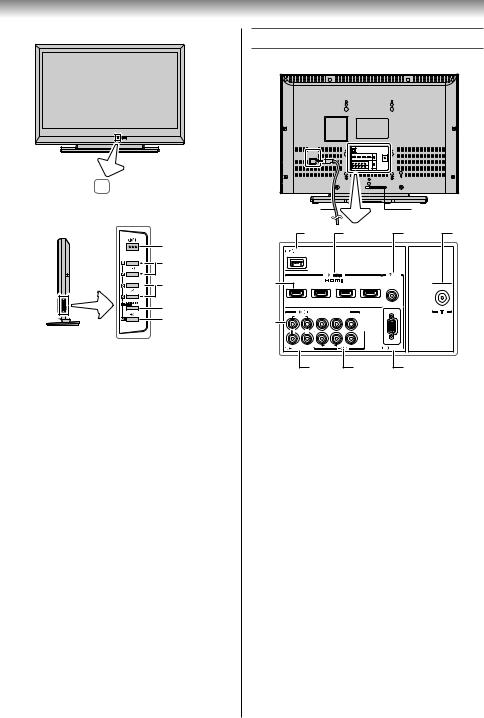
Introduction / Getting started
TV front view
 Point the brightness sensor (-page 18).
Point the brightness sensor (-page 18).

 6
6
Right side view
1
2
3
4
5
1! (Power on/Standby) — Press to turn the TV on/ standby (- page 10).
2pBb (Programme position) — When no menu is on screen, these buttons select the programme position. (- page 12).
U u (MENU up/down) — When a menu is on-screen, these buttons function as up/ down menu navigation buttons (except for the input source selection) (- page 11).
32 – + (Volume) — When no menu is onscreen, these buttons adjust the volume level.
I i (MENU left/right) — When a menu is on-screen, these buttons function as left/right menu navigation buttons or adjust settings (- page 11).
4MENU — Press to access the menu system (- page 11).
RETURN — When a menu is on-screen, this button will take you back to the previous menu (- page 12).
5o (Input source selection) — When no menu is on screen, this button selects the input source (- page 20).
OK — When a menu is on-screen, this button will make a selection or take you to the next available menu layer (- page 11).
6! (Power LED) — Power indicator (- page 10).
TV back panel connections
TV back view










 AC IN
AC IN
Power cord* |
Cable holder* |
|
|
7 |
9 |
|
10 |
11 |
|
USB |
|
|
|
|
|
8 |
|
|
|
|
PC/ |
|
|
|
|
|
HDMI1 |
|
|
1 |
2 |
3 |
4 |
(AUDIO) |
|
|
|
|
|||||
13 |
|
2 COMPONENT VIDEO INPUT |
|
|
|
|
|
|
|
|
|
|
|
|
AUDIO(FIXED) |
1 |
|
RGB/PC |
|
|
|
|
15 |
14 |
|
12 |
|
Power cord *
*Make sure to insert the plugs firmly, when plugging the AC power cord into the TV set end and wall outlet end.
*Make sure to hold the plug, when unplugging the AC power cord.
*Never use other cord except for supplied AC power cord, and never use the supplied power cord for any other purpose.
*The exact power cord will vary according to the country.
Cable holder *
*You can use the cable holder to hold the aerial cable, video and audio cables etc.
Never grasp the holder when moving the TV.
7USB (input terminal) — Insert your USB storage device here to view photos (JPEG) (- page 28).
8o HDMI1 (input terminal) — High-Definition Multimedia Interface input receives digital audio and uncompressed digital video from an HDMI device or uncompressed digital video from a DVI device (- pages 25, 26).
9o HDMI2 – o HDMI4 (input terminal)
— High-Definition Multimedia Interface input receives digital audio and uncompressed digital video from an HDMI device (- page 25).
8
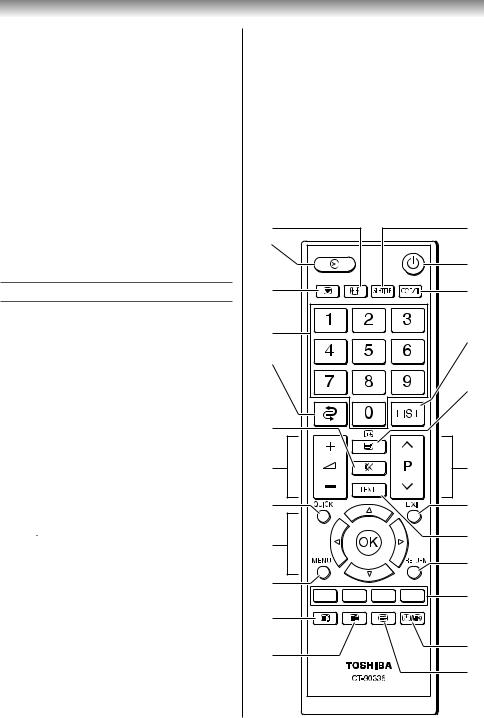
Introduction / Getting started
10o PC/HDMI1 (AUDIO) (input terminal) —
PC audio input terminal is shared with HDMI1 analogue audio input terminal, and their use can be configured in the SETUP menu (- pages 25, 26).
11A (Aerial input terminal) — Analogue aerial signal input (- page 7).
12o RGB/PC (input terminal) — For use when connecting a personal computer (PC) (- page 26).
13o (2) (Video 2 input terminals) — Highdefinition component video and standard (analogue) stereo audio inputs (- page 24).
14o (1) (Video 1 input terminals) —
Standard (composite) video and standard (analogue) stereo audio inputs (- page 24).
15O AUDIO (output terminals) — Standard audio outputs (FIXED) (- page 24).
Learning about the remote control
Location of controls
1Picture Size (- page 15)
2Subtitle on/off (- page 22)
3Input source selection (TV, o1, o2, HDMI1- 4, PC) (- page 20)
4Power on/Standby (- page 10)
5Picture still (- page 16)
6Stereo/Bilingual selection (- pages 18, 19)
7Number buttons (0-9) (- pages 12, 19, 22)
8To display the Channel List (- page 21)
9To return to the previous programme (- page 12)
10•  To display on-screen information
To display on-screen information
(- page 12)
• Initial/Index function for Teletext (- page 22)
Initial/Index function for Teletext (- page 22)
11Sound Mute (This button turns the sound off/ on.)
12Programme position U u (- page 12)
13Volume – + (These buttons adjust the volume level.)
14EXIT (- page 12)
15To access the Quick Menu (- page 11)
16Teletext on/Superimpose Teletext/off (- page 21)
17• Menu rsvw (- page 11)
• OK (- page 11)
18To return to the previous menu (- page 12)
19MENU (- page 11)
20Teletext control buttons (Four coloured buttons : Red, Green, Yellow, Blue) (- pages 21, 22)
21To reveal concealed text (- page 22)
22• To select a page while viewing a normal picture (- page 23)
• To select the time display (- page 23)
23To hold a wanted page (- page 23)
24To enlarge the teletext display size (- page 23)
1 |
2 |
|
3 |
|
|
|
4 |
|
5 |
6 |
|
7 |
8 |
|
|
||
9 |
|
|
|
10 |
|
11 |
|
|
13 |
12 |
|
15 |
14 |
|
17 |
16 |
|
18 |
||
|
||
19 |
20 |
|
|
||
21 |
|
|
23 |
22 |
|
24 |
||
|
||
|
9 |
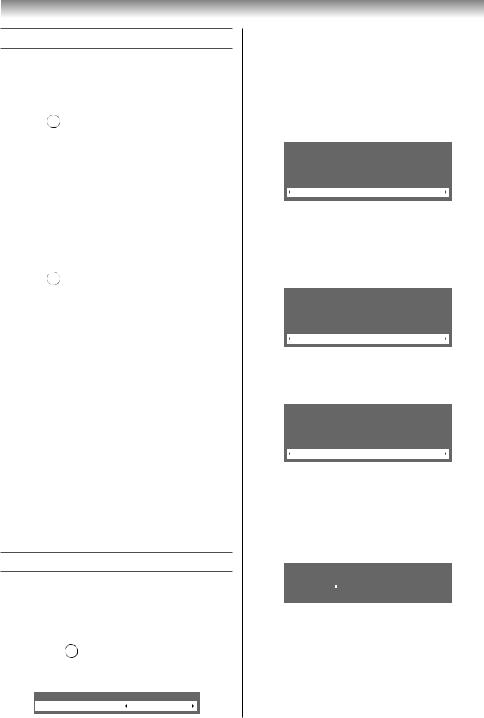
Introduction / Getting started
Turning the TV on
Switching on the TV
Connect the power cord to a wall outlet, the ! power indicator lights in red (standby mode).
1 Press  on the remote control or ! on the TV right side panel, the ! power indicator lights in green.
on the remote control or ! on the TV right side panel, the ! power indicator lights in green.
Note:
If you watch black and white programmes when the Colour System mode is set to Auto, colour noise may appear on the screen. In this case select the appropriate Colour System (For the system of each country or region, refer to pages 13, 31).
Switching off the TV
1 Press  on the remote control or ! on the TV right side panel to switch to the standby mode.
on the remote control or ! on the TV right side panel to switch to the standby mode.
Notes:
•When the TV will not be used for a long period of time, such as during vacation or travel, remove the power plug from the wall outlet.
•The TV will automatically turn itself off after approximately 15 minutes if it is tuned to a vacant channel or a station that completes its broadcast for the day. This function does not work in external input or Blue screen Off mode. The TV will automatically turn itself off after approximately 2 hours if you do not operate the
TV after turned on by on timer function.
•If power is cut off while you are viewing the TV, the Last Mode Memory function turns on the
TV automatically when power is applied again. If power is going to be off for a long time and you are going to be away from your TV, unplug the power cord to prevent the TV from turning on in your absence.
Tuning the TV for the first time
Before switching on the TV, put your decoder and media recorder to standby, if they are connected, and ensure that the aerial is connected.To setup the TV, use the buttons on the remote control as detailed on page 9.
1 Press the  button.The Quick Setup screen will appear.This screen will appear the first time that the TV is switched on.
button.The Quick Setup screen will appear.This screen will appear the first time that the TV is switched on.
Quick Setup
Language |
English |
2 Press v or w to select the menu language (English, Chinese (CS), Malay, Thai, Vietnamese, Russian, Arabic, Persian or
French).
3 Press Q, to display the Location menu (- page 13).
Press v or w to select Store or Home. For normal home use, select Home.
Location
To use the TV for displaying in
a store showroom, please select [Store]. [Home] mode is recommended
for normal use.
Home
Store mode:
AutoView menu is not available.
4 Press Q to display the AutoView menu (- page 16).
Press v or w to select Yes or No.
AutoView
AutoView mode automatically adjusts picture settings to suit ambient light conditions. Do you wish to enable AutoView mode?
Yes
5 Press Q to display the Auto Signal Booster menu (- pages 12, 13), and then v or w to select Yes or No.
Auto Signal Booster
Signal Booster boosts weak analogue broadcast signals. If you select [Yes], the TV will automatically set this feature to [On] or [Off] according to signal strength.
Do you wish to enable automatic control?
Yes
Yes mode :
This function performs automatic distinction of On or Off.
6 Press Q to display the Auto Tuning startup screen. Press Q to start the automatic search.
Auto Tuning |
|
|
Progress |
Found |
|
1% |
|
0 |
|
||
When the automatic search is completed, the TV will automatically appear the Manual Tuning menu (- page 13).
10
